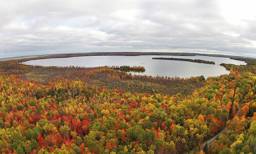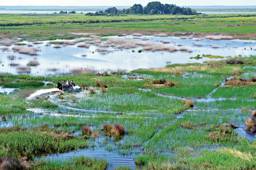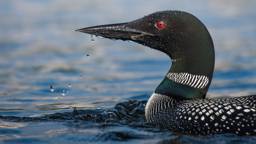No More Mr. Minnesota Nice
One day last August, Johnson, a retired public safety officer, noticed a new sign at the public access of Townline Lake, a shallow, clear, 600-acre body of water just east of Leech Lake, one of Minnesota’s prime sportfishing waters. The sign stated that Townline Lake was infested with watermilfoil, near the public access. “There was no notification of lakeshore owners, nothing,” he says.
In contrast to some, who want to keep watermilfoil on their lakes hushed up for fear of it affecting their property values, Johnson says “I’ve been telling everyone. I wanted to close off the public access last summer,” in part to protect other prime fishing lakes nearby. “I go a little bit crazy because I tend to get involved in things,” he says.
“Townline Lake is very clean,” he adds. “It’s a unique body of water and we want to keep it clean.”
With the help of Darrel Hoverson, invasive aquatic species specialist with the Minnesota Department of Natural Resources, Johnson and other lakeshore owners started gathering information. In the process, they found out that state funds for fighting watermilfoil had been withdrawn due to a budget crisis.
So residents formed a lake association solely to manage watermilfoil. They expect to spend up to $3,000 to buy and apply triclopyr (sold under the brand name Renovate), a selective, systemic herbicide allowed for use in Minnesota lakes by permit. Some herbicides can occasionally work too well, however, and kill desirable plants due to variations in application.
Despite environmental concerns, Johnson said triclopyr seemed the best of the chemical options because it’s more selective.
Getting Their Hands Dirty in the Empire State
In New York State, “We encourage mechanical methods, pulling it out by the roots,” says Douglas Stang, assistant director of fish, wildlife and marine resources for the Department of Environmental Conservation. “It can work in places where it’s not that well-established.”
Some lake associations have floating weed harvesters that cut or pull the top parts of the weeds, which makes boating and swimming more pleasant for the season but must be repeated yearly. Harvesters also leave weed fragments, which will sprout new plants if the scraps aren’t gathered.
That’s the scenario in the Adirondacks, home to 3,000-some lakes including Hickey’s own Mountain View and Indian lakes.
Last summer, a team of volunteers on boats and trained divers harvested watermilfoil, pulling it out by its roots and scooping up fragments in nets for disposal on land. “One day, between the two lakes, there must have been 50 people out there,” says Hickey, past president of the Mountain View Lake Association. “It was like a parade was going on.”
Chief among them was Darrel Dupra, association officer and designer and builder of “The Mangler” – a sort of weed combine that pulls plants up on a conveyor belt to be dumped later into shuttle boats.
Hickey says years of effort have resulted in great success on Indian Lake but only mixed results on Mountain View. That’s because Indian Lake has a sandy bottom, which seems less conducive to the plant’s growth, whereas Mountain View Lake is more shallow and muck-filled.
It may sound like a lot of work, but Hickey says there’s a community spirit. “We only do it for a couple hours at a time so we don’t tire anyone out. Then we have a refreshment or two. Everybody has fun.”
Fun while fighting an invasive species? These lake associations make it look easy.
One day last August, Johnson, a retired public safety officer, noticed a new sign at the public access of Townline Lake, a shallow, clear, 600-acre body of water just east of Leech Lake, one of Minnesota’s prime sportfishing waters. The sign stated that Townline Lake was infested with watermilfoil, near the public access. “There was no notification of lakeshore owners, nothing,” he says.
In contrast to some, who want to keep watermilfoil on their lakes hushed up for fear of it affecting their property values, Johnson says “I’ve been telling everyone. I wanted to close off the public access last summer,” in part to protect other prime fishing lakes nearby. “I go a little bit crazy because I tend to get involved in things,” he says.
“Townline Lake is very clean,” he adds. “It’s a unique body of water and we want to keep it clean.”
With the help of Darrel Hoverson, invasive aquatic species specialist with the Minnesota Department of Natural Resources, Johnson and other lakeshore owners started gathering information. In the process, they found out that state funds for fighting watermilfoil had been withdrawn due to a budget crisis.
So residents formed a lake association solely to manage watermilfoil. They expect to spend up to $3,000 to buy and apply triclopyr (sold under the brand name Renovate), a selective, systemic herbicide allowed for use in Minnesota lakes by permit. Some herbicides can occasionally work too well, however, and kill desirable plants due to variations in application.
Despite environmental concerns, Johnson said triclopyr seemed the best of the chemical options because it’s more selective.
Getting Their Hands Dirty in the Empire State
In New York State, “We encourage mechanical methods, pulling it out by the roots,” says Douglas Stang, assistant director of fish, wildlife and marine resources for the Department of Environmental Conservation. “It can work in places where it’s not that well-established.”
Some lake associations have floating weed harvesters that cut or pull the top parts of the weeds, which makes boating and swimming more pleasant for the season but must be repeated yearly. Harvesters also leave weed fragments, which will sprout new plants if the scraps aren’t gathered.
That’s the scenario in the Adirondacks, home to 3,000-some lakes including Hickey’s own Mountain View and Indian lakes.
Last summer, a team of volunteers on boats and trained divers harvested watermilfoil, pulling it out by its roots and scooping up fragments in nets for disposal on land. “One day, between the two lakes, there must have been 50 people out there,” says Hickey, past president of the Mountain View Lake Association. “It was like a parade was going on.”
Chief among them was Darrel Dupra, association officer and designer and builder of “The Mangler” – a sort of weed combine that pulls plants up on a conveyor belt to be dumped later into shuttle boats.
Hickey says years of effort have resulted in great success on Indian Lake but only mixed results on Mountain View. That’s because Indian Lake has a sandy bottom, which seems less conducive to the plant’s growth, whereas Mountain View Lake is more shallow and muck-filled.
It may sound like a lot of work, but Hickey says there’s a community spirit. “We only do it for a couple hours at a time so we don’t tire anyone out. Then we have a refreshment or two. Everybody has fun.”
Fun while fighting an invasive species? These lake associations make it look easy.
Steve Johnson and Jerry Hickey are two men separated by hundreds of miles and joined by one obnoxious aquatic weed.
Not literally joined, mind you. And not by one single weed plant – rather, by one species: Myriophyllum spicatum, also known as Eurasian watermilfoil, an invasive exotic plant that can harm a lake’s ecosystem and recreational value.
An Uninvited Guest
Johnson, who lives on northern Minnesota’s Townline Lake, admits to going “a little bit crazy” on discovering watermilfoil in his lake last August. And half a continent away, Hickey says weed-battling efforts have yielded “an unqualified success” on Indian Lake in New York’s Adirondacks and “an ongoing battle” on adjoining Mountain View Lake.
Johnson and Hickey are among hundreds of thousands of North American lakeshore owners looking at spending their time and money this summer battling Eurasian watermilfoil, which was first documented in a Washington, D.C. pond in 1942 and has since spread to nearly every U.S. state and three Canadian provinces. It’s particularly prevalent in the northeast and midwest United States, as well as Washington state, according to John Madsen, associate professor at Mississippi State University and researcher at the Geosystems Research Institute in Mississippi.
Wildlife managers don’t like Eurasian watermilfoil because it crowds out the native northern watermilfoil, which provides more suitable habitat for native fish species. And lakeshore owners hate it for – well, let’s count the reasons:
Natural resources experts say that although eradication is not feasible, some chemical and mechanical controls can manage the weed, if used correctly in the right situations. However, state program budgets are drying up, hammered by the Great Recession, so lakeshore owners are facing the prospect of paying more out of their own pockets.
Still, the experiences of Johnson and Hickey show that vigilance, cooperation and a can-do attitude go a long way toward making watermilfoil more manageable.
Not literally joined, mind you. And not by one single weed plant – rather, by one species: Myriophyllum spicatum, also known as Eurasian watermilfoil, an invasive exotic plant that can harm a lake’s ecosystem and recreational value.
An Uninvited Guest
Johnson, who lives on northern Minnesota’s Townline Lake, admits to going “a little bit crazy” on discovering watermilfoil in his lake last August. And half a continent away, Hickey says weed-battling efforts have yielded “an unqualified success” on Indian Lake in New York’s Adirondacks and “an ongoing battle” on adjoining Mountain View Lake.
Johnson and Hickey are among hundreds of thousands of North American lakeshore owners looking at spending their time and money this summer battling Eurasian watermilfoil, which was first documented in a Washington, D.C. pond in 1942 and has since spread to nearly every U.S. state and three Canadian provinces. It’s particularly prevalent in the northeast and midwest United States, as well as Washington state, according to John Madsen, associate professor at Mississippi State University and researcher at the Geosystems Research Institute in Mississippi.
Wildlife managers don’t like Eurasian watermilfoil because it crowds out the native northern watermilfoil, which provides more suitable habitat for native fish species. And lakeshore owners hate it for – well, let’s count the reasons:
- It forms dense, choking weed mats on lake surfaces.
- It clogs bays, shorelines and other important waterways.
- It tangles in boat motors.
- It can render beaches and swimming areas unusable.
Natural resources experts say that although eradication is not feasible, some chemical and mechanical controls can manage the weed, if used correctly in the right situations. However, state program budgets are drying up, hammered by the Great Recession, so lakeshore owners are facing the prospect of paying more out of their own pockets.
Still, the experiences of Johnson and Hickey show that vigilance, cooperation and a can-do attitude go a long way toward making watermilfoil more manageable.
Buckeye Battle
In Ohio, they’ve foregone chemicals and decided to fight watermilfoil the natural way. In 2002, EnviroScience, Inc. selected Lake Bonaparte in Stow, Ohio for an eight-year program to utilize a biological alternative for controlling Eurasian watermilfoil.
Using a process they’ve dubbed MiddFoil, they increased the existing population of a native aquatic weevil that feeds on the watermilfoil. As they feed and multiply, they knock down the level of watermilfoil and control its spread. Additionally, the weevils don’t harm other vegetation in the lake.
The program experienced positive results over the eight-year period, with a total disappearance of watermilfoil in a bay of the lake, and a reduction of watermilfoil to below nuisance levels throughout much of the lake. Additionally, the number of desirable native plant species in the lake increased five-fold by the end of the project.
Tom Wilkowske writes about milfoil, Millard Fillmore and many other subjects at his home in Duluth, Minn.
Reader Resources:
Renovate by SePRO, (317) 573-6172, www.sepro.com.
Aquacide pellets, (800) 328-9350, www.killlakeweeds.com.
Weed Roller, (800) 247-7335, www.weedroller.com.
Enviroscience, Inc., (800) 940-4025,
www.enviroscienceinc.com.
Reader Resource: EnviroScience, Inc., (330) 688-0111, www.enviroscienceinc.com.
In Ohio, they’ve foregone chemicals and decided to fight watermilfoil the natural way. In 2002, EnviroScience, Inc. selected Lake Bonaparte in Stow, Ohio for an eight-year program to utilize a biological alternative for controlling Eurasian watermilfoil.
Using a process they’ve dubbed MiddFoil, they increased the existing population of a native aquatic weevil that feeds on the watermilfoil. As they feed and multiply, they knock down the level of watermilfoil and control its spread. Additionally, the weevils don’t harm other vegetation in the lake.
The program experienced positive results over the eight-year period, with a total disappearance of watermilfoil in a bay of the lake, and a reduction of watermilfoil to below nuisance levels throughout much of the lake. Additionally, the number of desirable native plant species in the lake increased five-fold by the end of the project.
Tom Wilkowske writes about milfoil, Millard Fillmore and many other subjects at his home in Duluth, Minn.
Reader Resources:
Renovate by SePRO, (317) 573-6172, www.sepro.com.
Aquacide pellets, (800) 328-9350, www.killlakeweeds.com.
Weed Roller, (800) 247-7335, www.weedroller.com.
Enviroscience, Inc., (800) 940-4025,
www.enviroscienceinc.com.
Reader Resource: EnviroScience, Inc., (330) 688-0111, www.enviroscienceinc.com.
 © Alison Fox, University of Florida, www.bugwood.org
© Alison Fox, University of Florida, www.bugwood.org  © dreamstime.com
© dreamstime.com 









